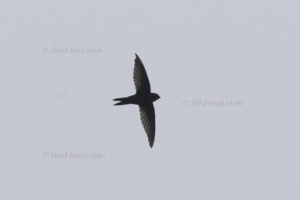 Swifts (Apodiformes) in the family Apodidae are small birds which spend the majority of their lives flying. These birds have very short legs and never settle voluntarily on the ground, perching instead only on vertical surfaces. Many swifts have long swept-back wings which resemble a crescent or boomerang. There are 13 species occurring in Cameroon. In a Rockjumper trip to Cameroon in April 2017, swifts were encountered almost every day with Little swift (Apus affinis) and African palm-swift (Cypsiurus parvus) being by far the most common. The best shots of Swifts and Swallows during the trip you will finde in the gallery “Swift and Swallows over Sanaga River in Cameroon” .
Swifts (Apodiformes) in the family Apodidae are small birds which spend the majority of their lives flying. These birds have very short legs and never settle voluntarily on the ground, perching instead only on vertical surfaces. Many swifts have long swept-back wings which resemble a crescent or boomerang. There are 13 species occurring in Cameroon. In a Rockjumper trip to Cameroon in April 2017, swifts were encountered almost every day with Little swift (Apus affinis) and African palm-swift (Cypsiurus parvus) being by far the most common. The best shots of Swifts and Swallows during the trip you will finde in the gallery “Swift and Swallows over Sanaga River in Cameroon” .
Common Swift (Apus apus) are probably the 3rd most abundant and could be seen and photographed especially in the lowlands near the Sanaga River close to Edea in the south-west corner of Cameroon. A gallery of flying birds of Sanager river – Swallows and Swifts – show the great potential for birders and photographers.
Numbers of Common Swifts are declining throughout Europe. A third of British Swifts e.g. have been lost since 1995. But the reasons underpinning this decline are unclear. Scientists of the British Trust for Ornithology (BTO ) are involved in a project aiming to address these knowledge gaps. Tiny geolocators were fitted to adult Swifts captured at the nest in summer 2010 and retrieved in summer 2011 when these birds returned to breed. The results of this work are revealing the migration routes and important wintering areas for this species, which could help to identify key areas for Swift conservation.
The first results show the incredible annual journey. The wintering range of individual Swifts is huge, with birds visiting several countries across Africa once they’ve completed their post-breeding season migration. Swifts also live up to their name, with one individual taking only 5 days to travel 5,000 km from West Africa back to the UK.
The journey of one tagged Common Swift by the BTO show a wintering ground which consisted large areas over Congo and the Central African Republic which is south-east of Cameroon. In April, the masses of Common Swift over Cameroon might show them on their migration back to the breeding grounds.
A scientific project revealed stopovers in West Africa of several days. Presumably the birds are fattening ready for their journey back to Europe. Previously it was thought that Common Swifts simply make their way more slowly, but directly, feeding as they go, without the need for extended stopovers.
A relative of the Common Swift (Apus apus) is the African Black Swift or African Swift (Apus barbatus). African black swifts appear bulky and entirely blackish-brown except for a small white or pale grey patch on the chin which is not visible from a distance. It has a short forked tail and very long swept-back wings that resemble a crescent or a boomerang. This species is very similar to Common Swift but can be distinguished under optimum viewing conditions by the contrast between its black back and paler secondary wing feathers. The heavier build also gives it a distinctive flight action, which consisted of a steady level flight interspersed with short glides. Another black swift living in Cameroon is the Bates’s swift (Apus batesi). This species is a small swift (smaller than Common Swift) with deeply forked tail and a distinctive high-speed flight with rapid flickering wingbeats.
Common Swift and African Swift might occur together in the northern winter. African Swifts breed in Africa discontinuously from Liberia, Cameroon, Zaire, Uganda and Kenya south to South Africa. Although they breed in damp mountains, high up (between 1,600 – 2,400 m asl), this species feeds readily over lowland, and can form very large flocks, often with other gregarious swifts as the Common Swift. But as a consequences of difficulties to separate the two black swift, a positive identification of African Swifts were only possible during our excursion to the Bamenda Highlands.
Bird-lens is mainly a website to suit the growing demand for top shots of the species of the Western Palearctic. But of interest is the phenomenon of bird migration in general. Trips to tourist and non-tourist spots like Thailand or the Seychelles to capture images of rare migrating birds are part of the program and were already very successful. More nice images you find in the gallery or in the “Pictures Shop”. Just give me a message, if Bird-lens could serve you with images also outside the range of the Western Palearctic. Images of e.g. South America are well on stock, too. The nice images you find in in the gallery “Swift and Swallows over Sanaga River in Cameroon” are only a first impression, what you might find in the gallery in the “Picture Shop” too. Just give bird-lens.com a message, if bird-lens.com could serve you with an image needed before other pictures are online.